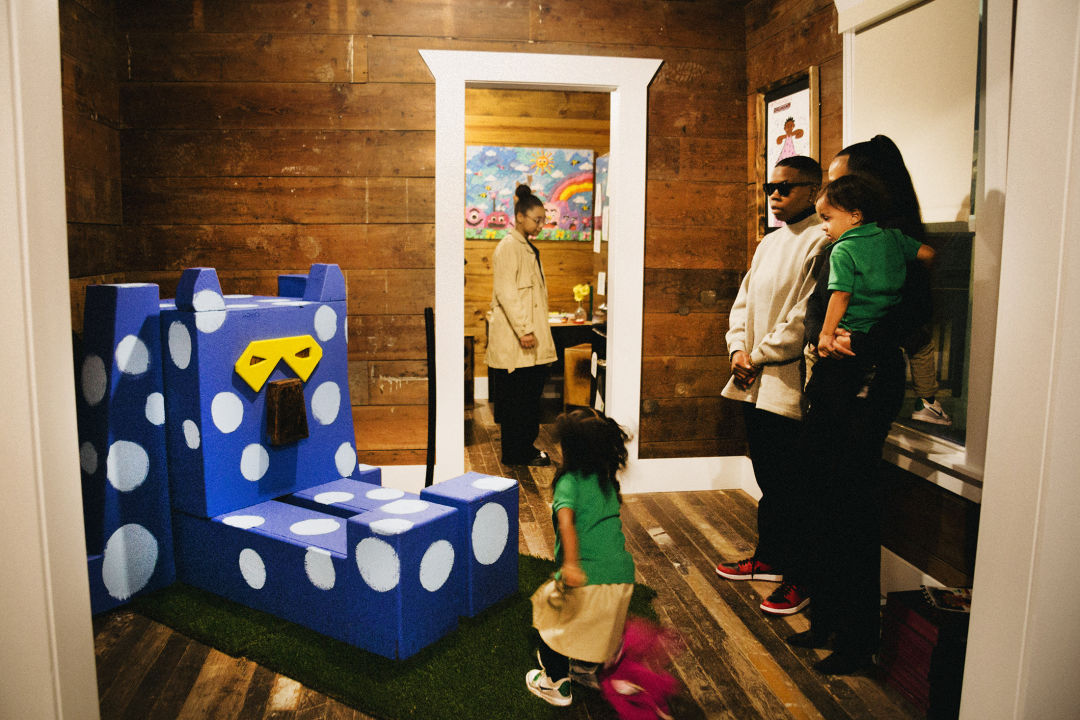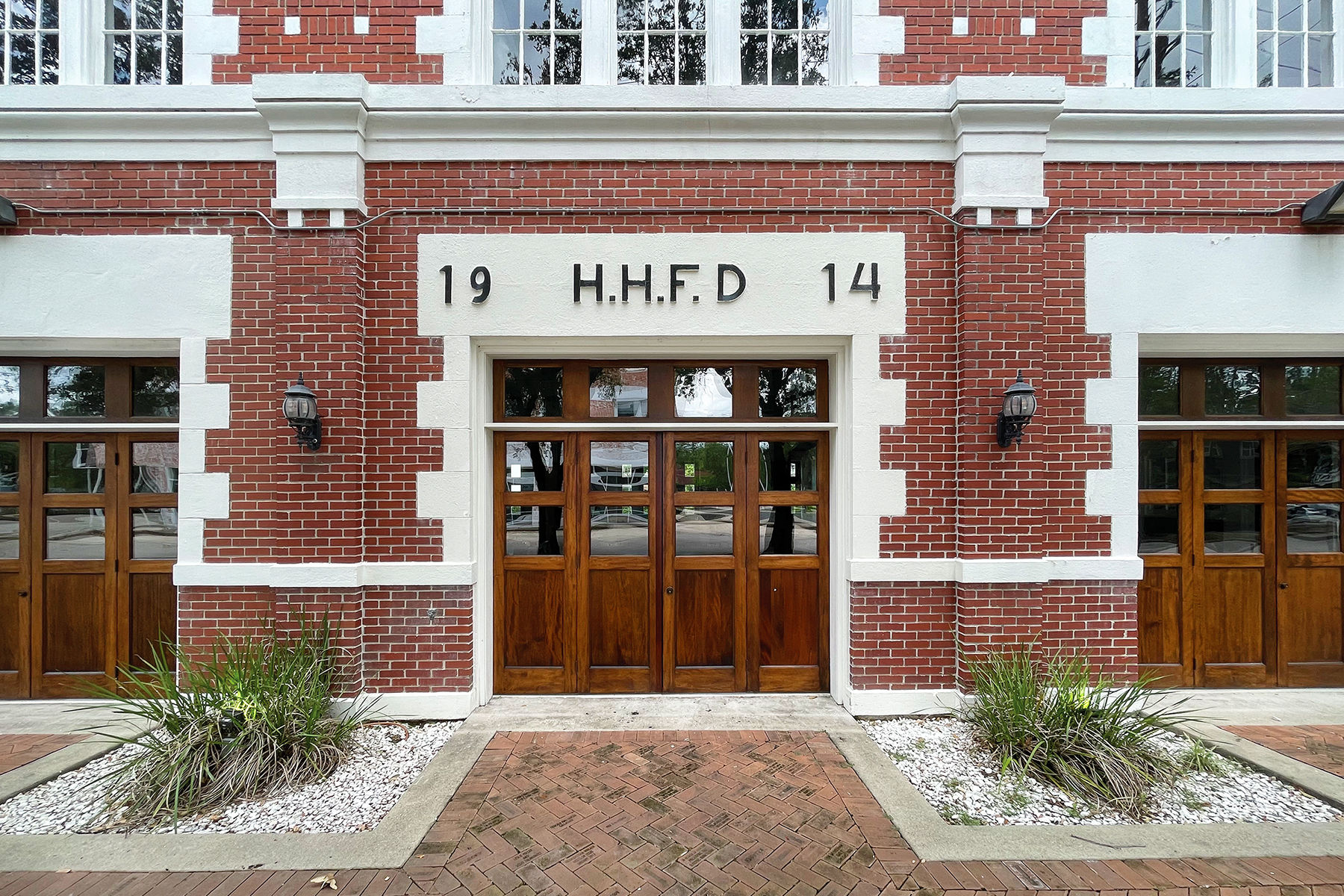Bennett Road Blends Freedmen’s Town History with the Joy of Play

Houstonia’s The Must List tells you about something going on in Houston that you absolutely cannot miss.
A cheerful series of bright row houses along Victor Street came to life in the middle of Fourth Ward in November 2024. The Houston Freedmen’s Town Conservancy Visitor Center opened next door four months prior, dedicated to sharing and preserving the titular neighborhood’s critical place in Texas history. Established in 1865 as a community for liberated slaves alongside the advent of Juneteenth, Freedmen’s Town is now recognized by UNESCO’s Slave Route Project as the home of multiple Sites of Memory.
The row houses are currently the stage for Bennett Road, the latest exhibit of HFTC’s Rebirth in Action partnership with Contemporary Arts Museum Houston. Launched in 2022, the partnership is designed to both amplify the history of and create opportunities for artists to craft works that respond directly to a Fourth Ward context and space.
“Without Freemen’s Town, there will be no Black culture in Houston. That is not emphasized enough, in my opinion,” says Charonda Johnson, the engagement manager for the HFTC and CAMH partnership and a fifth-generation resident of the historic neighborhood.
Bennett Road, by brothers Michael and Martellus Bennett, is a reflection on Black labor, family, and the delights of play and community, occupying two of the row houses until February 28. It’s part of a free one-hour tour of Freedmen’s Town, which includes the visitor center itself and the African American History Research Center at the Gregory School. Both Bennetts played football at Alief Taylor High School and Texas A&M before moving on to the NFL, where they both clinched Super Bowl wins. They have since retired, turning to lives of art and providing thoughtful examinations of the different demands inherent to each discipline.
“They’re both humanitarians, they’re both activists, and those are the types of individuals that, of course, we need now more than ever to be focused on communities such as Freemen’s Town,” says Mich Stevenson, projects manager of the HFTC and CAMH partnership. “And then I think you also look at the fact that both of them could be doing anything else, but right now, they’re both making art to engage community. There’s a labor of your body that you spent your life giving your body to a sport, and been successful at it, and that can come at the toll of the expense of your creativity and your mind.”
The first home in the show features pieces designed by both brothers. As the founder of the design-oriented Studio Kër, Michael's work explores Black history and heritage, including his own African Haitian background and childhood in the American South. Gumbo Stool, one of the first pieces encountered upon entering the building, exemplifies his themes. It pays homage to the necessity of oral tradition and storytelling in ensuring the survival of Black culture under systemic threats of suppression. Martellus's ruminations on resilience are also present throughout the home, including illustrations of extreme weather events softened by the scattering of delicate yellow flower petals and vases, table, and chairs stained using a Japanese wood-burning technique known as shou sugi ban.
Next door, Martellus has filled the house with an installation that’s all about connecting and learning through play. Sneakers lay tossed on the floor, while a kitchen table overflows with crayon drawings—a relatable scene to many kids and parents. Keep exploring and meet up with illustrations of Mr. TOMONOSHi! and Little Brown Girl, two of the artist’s beloved original characters who appear throughout his work. The former is what Martellus refers to as “the fun friend, that person whose living in a dream,” while Little Brown Girl is a lively template he uses to create more friends for her.
They live together as a family on Bennett Road, where neighborhood kids come to visit, play, and form a community in Freedmen’s Town. There’s even a Rothko Chapel–esque quiet room, where visitors can shut the door and contemplate alongside calm portraits of Little Brown Girl. But even in a home full of books and video games and cartoons and art supplies, the overarching themes of Black labor are still front and center.
“It reminds you that your labor can be your labor of love,” says Terrell Jackson-Owens, HFTC’s Visitor’s Center manager.
The handiwork of Jett, Martellus’s 11-year-old daughter, joins that of her father and uncle in Bennett Road. Open the refrigerator and come face-to-face with some truly accomplished clay sculptures of sushi rolls and cake. It’s a deeply personal touch to an already loving homage to family and friends, which the artist (and self-proclaimed “girl dad”) believes needs to be shown more often when it comes to holistically conveying the Black experience.
“I think people don’t really understand how much Black joy cost, but they have a dollar amount for Black trauma, because they know how much trauma has cost,” he says. “But in the show…my entire body of work, all I’m trying to do is impress my daughter… I draw more cute than I did previously.”

Charonda Johnson herself once lived in the home where Martellus’s installation is currently on display, adding a deeply personal touch and historic context to the show. Imagining her childhood—albeit through a lens inspired by Hello Kitty, race cars, and Pixar movies, among many other eclectic influences—helped shape Martellus’s final kinetic and spirited vision for Bennett Road.
“What was it like to grow up in that house? I know a lot of little brown girls who grew up in a house like that before,” Martellus says.
Such a bridging of past and present also directly addresses HFTC’s mission to preserve Houston’s Black history, which also includes the restoration of historic homes and even local archaeological expeditions; one excavated a nineteenth century bell cistern within the Freedmen’s Town boundaries. Johnson witnessed arsonists burning down a church from the window of this home, too, and considered the shou sugi ban furniture pieces in both sections of Bennett Road something of a full-circle moment.
“It was those moments that I guess have burned and itched into my head, and then for this particular exhibit to display the same kind of burning styles, it kind of brought it back home,” she says.
Know Before You Go
Bennett Road is part of the Houston Freedmen’s Town Conservancy’s one-hour tour, and will be on display until February 28. Admission is free. Learn more at the website.




